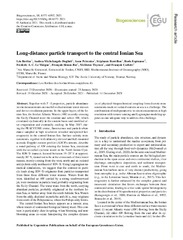Long-distance particle transport to the central Ionian Sea
Permanent link
https://hdl.handle.net/10037/23999Date
2021-12-14Type
Journal articleTidsskriftartikkel
Peer reviewed
Author
Berline, Léo; Doglioli, Andrea Michelangelo; Petrenko, Anne; Barrillon, Stéphanie; Espinasse, Boris Dristan; Le Moigne, Frederic A. C.; Simon-Bot, François; Thyssen, Melilotus; Carlotti, F.Abstract
Together with T –S properties, particle abundance
in situ measurements are useful to discriminate water masses
and derive circulation patterns. In the upper layers of the Ionian Sea, the fresher Atlantic Waters (AW) recently crossing
the Sicily Channel meet the resident and saltier AW, which
circulated cyclonically in the eastern basin and modified after evaporation and eventually cooling. In May 2017, during the PEACETIME cruise, fluorescence and particle abundance sampled at high resolution revealed unexpected heterogeneity in the central Ionian Sea. Surface salinity measurements, together with altimetry-derived and hull-mounted
acoustic Doppler current profiler (ADCP) currents, describe
a zonal pathway of AW entering the Ionian Sea, consistent
with the so-called cyclonic mode in the North Ionian Gyre.
The ION-Tr transect, located between 19–20◦ E at approximately 36◦ N, turned out to be at the crossroads of three water
masses, mostly coming from the west, north and an isolated
anticyclonic eddy northeast of ION-Tr. Using Lagrangian numerical simulations, we suggest that the contrast in particle loads along ION-Tr originates from particles transported
from these three different water masses. Waters from the
west, identified as AW carried by a strong southwestward
jet, were moderate in particle load, probably originating from
the Sicily Channel. The water mass from the north, carrying
abundant particles, probably originated in the northern Ionian Sea, or further away from the south Adriatic Sea. Waters
from the eddy, depleted in particles and chl a, may originate
from south of the Peloponnese, where the Pelops eddy forms.
The central Ionian Sea hence appears as a mosaic area,
where waters of contrasted biological history meet. This contrast is particularly clear in spring, when blooming and nonblooming areas co-occur. Interpreting the complex dynamics of physical–biogeochemical coupling from discrete measurements made at isolated stations at sea is a challenge. The
combination of multiparametric in situ measurements at high
resolution with remote sensing and Lagrangian modeling appears as one adequate way to address this challenge.
Publisher
Copernicus PublicationsCitation
Berline, Doglioli, Petrenko, Barrillon, Espinasse, Le Moigne, Simon-Bot, Thyssen, Carlotti. Long-distance particle transport to the central Ionian Sea. Biogeosciences. 2021;18(24):6377-6392Metadata
Show full item recordCollections
Copyright 2021 The Author(s)


 English
English norsk
norsk